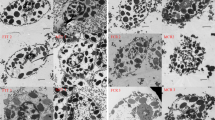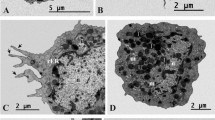Abstract
This work was aimed at analyzing the features of the morphology and morphometric parameters of eosinophils and their granules in the raccoon dog Nyctereutes procyonoides (Grey, 1834). Pappenheim staining of blood smears was used to determine white-blood-cell count and to assess the features of the morphology and morphometric parameters of eosinophils and their granules. Cytochemical methods were used to determine localization of cationic proteins, as well as eosinophilic peroxidase in eosinophils. ANOVA was used to assess gender effects. The study has shown that raccoon dogs are characterized by a high relative content of eosinophils (7–10% of the total population of white blood cells), as well as by the presence of large secretory granules in them. In addition to eosinophils with the typically rich cytoplasmic granularity, larger cells containing secretory granules in minor quantities and, in some cases, vacuole-like granules were present in blood smears. Gender effects manifested themselves in the higher proportion of eosinophils with a low level of cytoplasmic granularity in males compared to females, while females showed higher values of morphometric parameters (the number and mean area of granules in a single cell, as well as the ratio of the area taken by granules to the cell area). Since the causes of the appearance of eosinophils with a low content of granules, as well as with vacuolization of the cytoplasm, in raccoon dogs are not quite clear, this problem needs further investigation.

Similar content being viewed by others
REFERENCES
Abu-Ghazaleh, R.I., Dunnette, S.L., Loegering, D.A., Checked, J.L., Kita, H., Thomas, L.L., and Gleich, G.J., Eosinophil granule proteins in peripheral blood granulocytes, J. Leukocyte Biol., 1992, vol. 52, no. 6, p. 611.
Anaev, E.Kh., Eosinophils and eosinophilia, Atmos. Pul’monol., Allergol., 2002, vol. 6, no. 3, p. 15.
Bebo, B.F., Jr., Fyfe-Johnson, A., Adlard, K., Beam, A.G., Vandenbark, A.A., and Offner, H., Low-dose estrogen therapy ameliorates experimental autoimmune encephalomyelitis in two different inbred mouse strains, J. Immunol., 2001, vol. 166, p. 2080. Bondar’, T.P., Ishkova, N.M., and El’kanova, A.B., Study of densitometric characteristics of peripheral blood eosinophils in diseases of infectious-allergic nature, Nauka. Innov. Tekhnol., 2011, vol. 74, p. 5. Bondar’, T.P. and El’kanova, A.B., Mechanism of changes in the morphofunctional state of eosinophils in eosinophilia of different genesis in children, Sovrem. Probl. Nauki Obraz., 2014, vol. 2, p. 345.
Denzler, K.L., Farmer, S.C., Crosby, J.R., Borchers, M., Cieslewicz, G., Larson, K.A., Cormier-Regard, S., Lee, N.A., and Lee, J.J., Eosinophil major basic protein-1 does not contribute to allergen-induced airway pathologies in mouse models of asthma, J. Immunol., 2000, vol. 165, p. 5509.
Fettrelet, T., Gigon, L., Karaulov, A., Yousefi, S., and Simon, H.U., The enigma of eosinophil degranulation, Int. J. Sci., 2021, vol. 22, p. 7091.
Giori, L., Gironi, S., Scarpa, P., Anselmi, A., Gualtieri, M., and Paltrinieri, S., Grey eosinophils in sighthounds: frequency in 3 breeds and comparison of eosinophil counts determined manually and with 2 hematology analyzers, Vet. Clin. Pathol., 2011, vol. 40, p. 475.
Hamano, N., Terada, N., Maesako, K., Numata, T., and Konno, A., Effect of sex hormones on eosinophilic inflammation in nasal mucosa, Allergy Asthma Proc., 1998, vol. 19, p. 263.
Hayhoe, F.G. and Quaglino, D., Gematologicheskaya tsitokhimiya (Hematological Cytochemistry), Moscow: Meditsina, 1983.
Holmes, E., Raskin, R., McGill, P., and Szladovits, B., Morphologic, cytochemical, and ultrastructural features of gray eosinophils in nine cats, Vet. Clin. Pathol., 2021, vol. 50, p. 52.
Iazbik, M.C. and Couto, C.G., Morphologic characterization of specific granules in Greyhound eosinophils, Vet. Clin. Pathol., 2005, vol. 34, p. 140.
Matthews, S.P., McMillan, S.J., Colbert, J.D., Lawrence, R.A., and Watts, C., Cystatin F ensures eosinophil survival by regulating granule biogenesis, Immunity, 2016, vol. 44, p. 795.
Melo, R.C. and Weller, P.F., Contemporary understanding of the secretory granules in human eosinophils, J. Leukocyte Biol., 2018, vol. 104, p. 85.
Minzyuk, T.V., Kavtsevich, N.N., and Svetochev, V.N., New data on the blood cell composition of bearded seal, Dokl. Biol. Sci., 2015, vol. 462, p. 152.
Morales-Montor, J., Togno-Pierce, C., and Munoz-Cruz, S., Non-reproductive effects of sex steroids: their immunoregulatory role, Curr. Topics Med. Chem., 2011, vol. 11, p. 1714.
Mustonen, A.M., Asikainen, J., Aho, J., and Nieminen, P., Selective seasonal fatty acid accumulation and mobilization in the wild raccoon dog (Nyctereutes procyonoides), Lipids, 2007, vol. 42, p. 1155.
Newsome, F.V. and Ebeigbe, P., Blood eosinophil degranulation and vacuolation in helminthic infection, Ann. Tropical Med. Parasitol., 1991, vol. 85, p. 239.
Nowakowicz-Dębek, B., Zoń, A., Jakubczak, A., and Wnuk, W., Hematological parameters of wild and farm mink, red fox and raccoon dog, Med. Wet., 2013, vol. 69, p. 40.
Prin, L., Capron, M., Tonnel, A.B., Bletry, O., and Capron, A., Heterogeneity of human peripheral blood eosinophils: variability in cell density and cytotoxic ability in relation to the level and the origin of hypereosinophilia, Int. Arch. Allergy Immunol., 1983, vol. 72, no. 4, p. 336.
Rodrigo-Muñoz, J.M., Gil-Martínez, M., Sastre, B., and del Pozo, V., Emerging evidence for pleiotropism of eosinophils, Int. J. Mol. Sci., 2021, vol. 22, p. 7075.
Shubich, M.G., Detection of cationic protein in the cytoplasm of leukocytes using bromphenol blue, Tsitologiya, 1974, vol. 16, no. 10, p. 1321.
Tai, P.C. and Spry, C.J., Studies on blood eosinophils. I. Patients with a transient eosinophilia, Clin. Exp. Immunol., 1976, vol. 24, p. 415.
Tai, P.C. and Spry, C.J.F., The mechanisms which produce vacuolated and degranulated eosinophils, Br. J. Haematol., 1981, vol. 49, p. 219.
Tchernitchin, A.N., Barrera, J., Arroyo, P., Mena, M.A., Vilches, K., and Grunert, G., Degranulatory action of estradiol on blood eosinophil leukocytes in vivo and in vitro, Agents Actions, 1985, vol. 17, p. 60.
Uzenbaeva, L.B., Golubeva, A.G., Ilyuha, V.A., Tyutyunnik, N.N., and Korosov, S.A., Morphofunctional features of leukocytes of mammals bred in captivity in the conditions of the European North, Tr. Karel. Nauchn. Tsentra Ross. Akad. Nauk, 2007, vol. 11, p. 109.
ACKNOWLEDGMENTS
The authors are sincerely and deeply grateful to L.B. Uzenbayeva (Institute of Biology, Karelian Research Center of the Russian Academy of Sciences, Petrozavodsk) for valuable advice and recommendations when discussing the research results, as well as to E.F. Pechorina (Institute of Biology, Karelian Research Center of the Russian Academy of Sciences, Petrozavodsk) for her assistance in data processing.
Laboratory studies were performed using the research equipment of the Center for Collective Use of the Karelian Research Center of the Russian Academy of Sciences.
Funding
This work was funded from the federal budget for a state order for the Karelian Research Center of the Russian Academy of Sciences, no. FMEN-2022-0003.
Author information
Authors and Affiliations
Corresponding author
Ethics declarations
COMPLIANCE WITH ETHICAL STANDARDS
All procedures performed in the studies involving animals were in agreement with the ethical standards established by the legal acts of the Russian Federation, the principles of the Basel Declaration, and the recommendations of the Local Ethics Committee of the Institute of Biology, Karelian Research Center, Russian Academy of Sciences (Protocol no. 1 of January 16, 2023).
CONFLICT OF INTEREST
The authors declare that they have no conflicts of interest.
Additional information
Translated by E. Makeeva
Publisher’s Note.
Pleiades Publishing remains neutral with regard to jurisdictional claims in published maps and institutional affiliations.
Abbreviations: VG—vacuole-like granule; VE—vacuolated eosinophil; G-1, G-2—types of eosinophil granules; CP—cationic protein; EPO—eosinophil peroxidase; E-I, E-II—types of eosinophils; CF null—mouse with cystatine F deficiency; MBP-1—major basic protein 1.
Rights and permissions
About this article
Cite this article
Kalinina, S.N., Kizhina, A.G. & Ilyukha, V.A. Morphological Features and Morphometric Parameters of Eosinophils in Peripheral Blood of the Raccoon Dog Nyctereutes procyonoides (Grey, 1834). Cell Tiss. Biol. 17, 706–712 (2023). https://doi.org/10.1134/S1990519X23060081
Received:
Revised:
Accepted:
Published:
Issue Date:
DOI: https://doi.org/10.1134/S1990519X23060081




